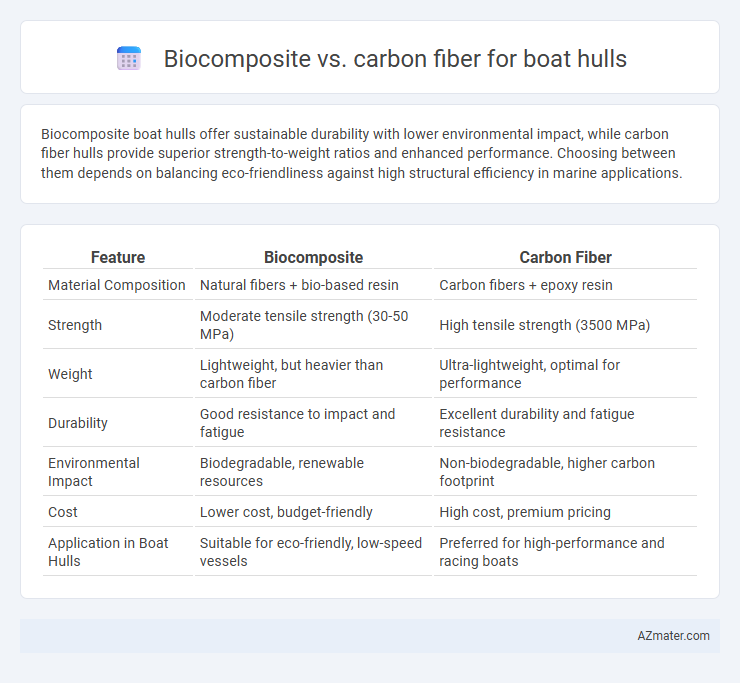Biocomposite boat hulls offer sustainable durability with lower environmental impact, while carbon fiber hulls provide superior strength-to-weight ratios and enhanced performance. Choosing between them depends on balancing eco-friendliness against high structural efficiency in marine applications.
Table of Comparison
| Feature | Biocomposite | Carbon Fiber |
|---|---|---|
| Material Composition | Natural fibers + bio-based resin | Carbon fibers + epoxy resin |
| Strength | Moderate tensile strength (30-50 MPa) | High tensile strength (3500 MPa) |
| Weight | Lightweight, but heavier than carbon fiber | Ultra-lightweight, optimal for performance |
| Durability | Good resistance to impact and fatigue | Excellent durability and fatigue resistance |
| Environmental Impact | Biodegradable, renewable resources | Non-biodegradable, higher carbon footprint |
| Cost | Lower cost, budget-friendly | High cost, premium pricing |
| Application in Boat Hulls | Suitable for eco-friendly, low-speed vessels | Preferred for high-performance and racing boats |
Introduction to Boat Hull Materials
Boat hull materials significantly influence vessel performance, durability, and environmental impact. Biocomposites offer a sustainable alternative with natural fibers and biodegradable resins, reducing ecological footprint while maintaining strength and flexibility. Carbon fiber delivers superior strength-to-weight ratio and stiffness, enhancing speed and fuel efficiency, though it comes with higher costs and less environmental sustainability.
What are Biocomposites?
Biocomposites are materials composed of natural fibers such as flax, hemp, or jute embedded in a polymer matrix, offering an eco-friendly alternative to traditional composites. They provide advantages in biodegradability, lower environmental impact, and reduced weight, making them suitable for sustainable boat hull construction. Compared to carbon fiber, biocomposites typically have lower strength and stiffness but can excel in vibration damping and cost-effectiveness for specific marine applications.
Understanding Carbon Fiber in Marine Applications
Carbon fiber offers exceptional strength-to-weight ratio and corrosion resistance, making it ideal for boat hulls that require durability and performance in marine environments. Its high stiffness enhances structural integrity, improving speed and fuel efficiency in vessels. Biocomposites provide an eco-friendly alternative but typically lack the rigidity and longevity of carbon fiber under harsh saltwater exposure.
Strength and Durability Comparison
Biocomposite boat hulls offer enhanced environmental sustainability while providing competitive strength through natural fiber reinforcements combined with resin matrices. Carbon fiber hulls exhibit superior tensile strength and stiffness, resulting in higher durability and resistance to impact and fatigue under harsh marine conditions. Despite carbon fiber's premium performance, biocomposites present a viable alternative with improving mechanical properties and eco-friendly benefits for sustainable boat manufacturing.
Weight and Performance Differences
Biocomposite boat hulls typically weigh more than carbon fiber counterparts due to the natural fibers and resin matrices used, resulting in slightly reduced acceleration and top speed. Carbon fiber offers superior strength-to-weight ratio, enhancing hull stiffness and responsiveness, which improves overall performance in competitive and high-speed marine applications. While biocomposites provide environmental benefits and adequate durability, carbon fiber remains the preferred choice for lightweight, high-performance boat hulls.
Environmental Impact and Sustainability
Biocomposite boat hulls significantly reduce environmental impact by using renewable natural fibers and biodegradable resins, resulting in lower carbon emissions during production and easier end-of-life disposal. Carbon fiber hulls, while offering superior strength-to-weight ratios, rely on energy-intensive manufacturing processes and non-recyclable materials that contribute to a larger carbon footprint. Sustainable boat manufacturing increasingly favors biocomposites for balancing performance with eco-friendly lifecycle benefits.
Cost Analysis: Biocomposite vs Carbon Fiber
Biocomposite boat hulls typically offer a lower initial material cost compared to carbon fiber, making them more attractive for budget-conscious projects. Carbon fiber provides superior strength-to-weight ratio and durability but often comes with higher manufacturing and repair expenses. Maintenance costs for biocomposites may be lower due to their environmental resistance, but carbon fiber's performance benefits can justify the premium investment in high-performance or competitive boating applications.
Maintenance and Longevity Factors
Biocomposite boat hulls offer improved biodegradability and easier repair compared to carbon fiber, requiring less specialized maintenance due to their natural fiber content and resin matrix. Carbon fiber hulls provide superior strength-to-weight ratio and resistance to fatigue, resulting in longer service life but necessitating expert inspection for potential delamination or micro-cracks. Maintenance frequency for biocomposite hulls tends to be higher due to environmental degradation, whereas carbon fiber demands costly, specialized upkeep to preserve its high-performance characteristics over decades.
Real-World Applications and Case Studies
Biocomposite materials in boat hulls offer enhanced sustainability and reduced environmental impact compared to traditional carbon fiber composites, proving valuable in eco-friendly marine projects such as the SeaPearl 21 sailboat. Carbon fiber remains preferred in high-performance racing yachts like the America's Cup boats due to its superior strength-to-weight ratio and stiffness, enabling faster and more agile vessels. Case studies demonstrate biocomposites excel in recreational and small-scale commercial boats by balancing durability with eco-conscious material sourcing, while carbon fiber dominates competitive and commercial applications demanding maximum structural performance.
Future Trends in Boat Hull Materials
Biocomposite materials are gaining traction in boat hull construction due to their sustainability, reduced environmental impact, and enhanced biodegradability compared to traditional carbon fiber. Carbon fiber continues to dominate high-performance marine applications with unmatched strength-to-weight ratios and durability, but innovations in bio-based resins and natural fiber reinforcements are accelerating biocomposite adoption. Future trends indicate a hybrid approach combining carbon fiber's mechanical advantages with biocomposite eco-friendliness, driven by regulatory pressures and shifting consumer preferences towards greener, lightweight, and corrosion-resistant hull materials.

Infographic: Biocomposite vs Carbon fiber for Boat hull
 azmater.com
azmater.com